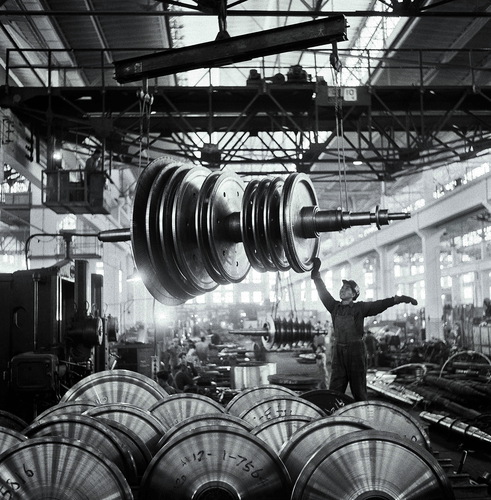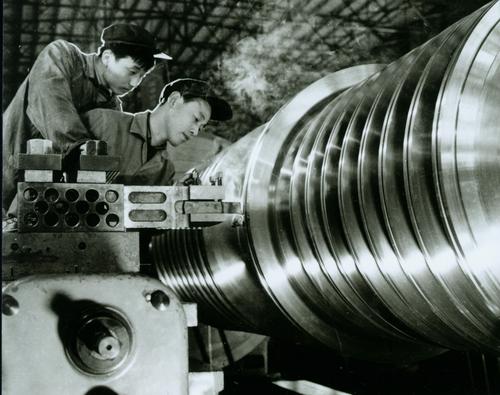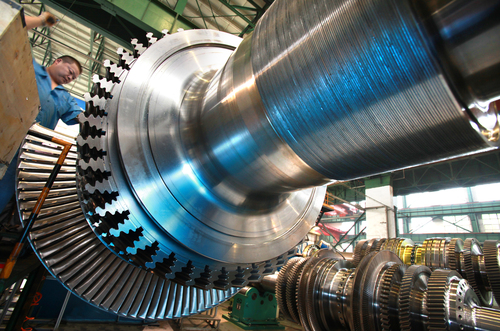In the early days of the founding of new China, a large number of heavy-industry factories relocated to along the Huangpu River in Minhang. Along with the evolution of various industries, the historic Minhang district turned itself into "a cradle of state-owned enterprises" and "a new industrial town." This was the place where the "four manufacturing stars" that Shanghai people were so proud of were formed. Shanghai Turbine Works ("Shanghai Turbine") was one of those.
As the city changed dramatically over the following 65 years, only Shanghai Turbine seemed to stay away from the crowd. Every corner of the factory is filled with camphor trees over 60 years old so thick that two people would not be able to join their arms around them. There are also several factory buildings around the same age as the camphor trees. It is hard to imagine that world-class steam turbines are designed and manufactured in this "nostalgic" old factory.
The 65-year-old factory has its own kind of "stubbornness." The exterior looks like a historic factory building, but it is quite a different story on the inside: everything from the walls to the floors is scrubbed clean and the production lines are arranged in perfect order. There are some important workstations where the staff must wipe the soles of their shoes clean before they can even take up their stations and some components must be wiped clean with white jersey fabric before being installed. This ensures that sources of dust and dirt are eliminated and that the 5S management standards are met. Thus, Shanghai Turbine has turned a run-down old workshop into a "model workshop."
This kind of "stubbornness" is one of the old factory's natural qualities. "Meticulous attention to detail and relentless pursuit of better" is part of Shanghai Electric's corporate culture. Shanghai Turbine has carved the phrase into the most central spot in their factory, while also instilling this spirit into their pursuit of excellence in all their technical innovations. They have always been setting new records in the history of China's steam turbine manufacturing, from small to large capacities, from thermal power to nuclear power, from the subcritical to the supercritical, and even to the ultra-supercritical. They have increased the unit capacity of steam turbine from 6,000 kW to 1,000 mW, an increase of over 160 times, incorporating 1 million kW steam turbines, heavy-duty gas turbines, and 1 million kW nuclear power steam turbines into their product portfolio. These achievements are all examples of the "meticulous attention to detail and relentless pursuit of better" spirit of Shanghai Turbine and Shanghai Electric.
Tracing the "meticulous attention to detail and relentless pursuit of better" spirit
At the beginning of 1951, New China had many matters to attend to. In one of Dalian City's generator factories, a 15,000 kW steam turbine suddenly malfunctioned which caused supply problems for the whole north-east power grid. Shanghai General Machine Factory, the predecessor of Shanghai Turbine, stepped up and took on the task that the whole nation was anxious about. They were miraculously able to get the near-ruined steam turbine working again without any drawings, without much equipment, and even without very much experience. In 1953, the government implemented its first five-year plan in which they decided to establish a power generator manufacturing base in Shanghai. It was logical that Shanghai General Machine Factory was renamed by the government as Shanghai Turbine Works following the fame they gained from repairing the steam turbine in Dalian.
On August 30, 1953, Shanghai Turbine came into being on the site of a former general machine factory that, at the time, could only produce electric hoists and small pumps. It was not long after its establishment that the factory was honored with the task to design and develop the first 6,000 kW steam turbine in China. All the factory could take advantage of was some world-class steam turbine drawings and a team of experts from Czechoslovakia. In terms of equipment, apart from a dynamic balancing machine procured upon approval, they could only use the factory's own dated equipment.
When the Czech experts opened up the drawings, the workers thought it was a case of "you can't make bricks without straw." As indicated in the drawings, the turbine blade roots should have a tolerance of 0.009 mm but the best equipment in the factory had a tolerance of 0.02 mm. A single steam turbine would need over 70 thousand components and the key components would need to be processed until they were one seventh the thickness of a hair. This was a huge leap in difficulty compared with the earlier repair job.
None of the hundreds of technicians involved in this task had suitable equipment. They had all been used to hand working and sculpting; they had no technical experience and were used to doing things by learning from mistakes. During the tightest moments of the project, Huang Jing, the then Minister of the nation's First Ministry of Machine Building, was present at the factory himself on two occasions to work alongside the workers. During the day, he would review the drawings and study up on difficulties associated with quality. Then he would go on-site to check on the quality. In the evening, he would stay in the dormitory and discuss with the workers for strategies and solutions. It was three months after that the rotors and blades produced in the factory completely met the quality standards.
Inside the steam turbine cylinder, a main shaft was equipped with an 8-stage impeller and an 8-stage bulkhead, the bulkhead being forged from cast iron. A problem that occurred when casting the bulkhead was that it would either be too slack or white pores would appear in it. The technicians and casting workers could not find the cause for some time. They thought long and hard about it as they were walking by the Huangpu River (the workshop was located by the river). Seeing the rising tide's back waves pushing the front waves and one wave rising higher than the next, Mr. Li, a casting worker, suddenly had a flash of inspiration and said, "If we increase the strength of the molding sand to a level that prevents it from the impact of the near 1,000-degree molten iron casting, perhaps there is a way to overcome the quality problem we've been having." "That's right!" said the deputy lead engineer, Cong Mian. "But we also need to mix an appropriate amount of salt (sodium chloride) into the molding sand to enhance coagulation." They were finally able to solve the bulkhead casting problem following a dozen of tests. This resulted in molding sand that could be reused and saved them large amounts of sandy mud. This molding technique was spread out across the casting industry both in Shanghai and all over the country.
Blades have always been considered the "heart" of any steam turbine. In a 6,000 kW steam turbine, over 2,000 blades were embedded into the impeller. They were subjected to the impact of 400+°C steam heat at a speed of 3,000 rpm. A problem with even one blade would affect the overall efficiency of the generator unit, so would sub-standard precision of the blades. This required that the blades be of high precision: 3-5 blade roots must not have a deviation of more than one seventh the size of a hair. A high-precision "double-head milling machine" was needed for machining blades and a dedicated "profiling machine" for machining blade roots. However, at that time, even the factory's best milling machine had a precision beyond 0.02 mm. What could they do? "Don't worry. We at the blade workshop won't be a drag on the project," said Zhu Shunyu, the deputy director of the blade workshop at the time. Thereupon, he led milling machine workers Huang Zheng and Liu Baolin to work on technological innovations. With the help of engineer Wan Dingguo, they invented a "semi-automatic profiling tool" and installed it for testing in an ordinary milling machine. The tool's feasibility was successfully demonstrated after several improvements. The quality of the resulting blades completely met the design requirements.
A 6,000 kW steam turbine contained a rotor that is over two tons in weight. People nervously watched the operator when they placed one such rotor for grinding on an "old-fashioned" cylindrical grinder. This was because what they were doing involved the most difficult "red slip" key technique for the assembly of the steam turbine components. What is meant by "red slip?" Let's use an analogy. Suppose a bottle lid is stuck and just won't open. If you heat it up then the lid will suddenly be able to be twisted open. This is called "expansion and contraction." The eight impellers of a 6,000 kW steam turbine need to be fitted tightly around the rotor. By using the same principle of expansion and contraction you can first heat the inner bore of the impeller with a flame and then slip it over the rotor. It will be set place once it is cooled down. This is called "impeller red slip." Thus, the miller worker needed to grind the rotor's outer diameter to be very fine, down to just 0.2 mm larger than the impeller's internal bore. If it were ground to be too large, then the component would not have gone in. If it were ground to be too small, then the component would not have set in place.
The most important day of the project was witnessed by Minister Huang Jing as well as the Czech experts. What they saw was the workers and craftsmen calmly and attentively relying on their years of experience to grind and carefully observe the sparks flying off in order to assess precision. When the grinder had stopped, an assembly technician took measurements with an outside micrometer; it was exactly the size of the impeller red slip. Then, all the eight impellers were heated on their inner bores and steadily set onto the rotor. Everyone present, including Minister Huang, could then breathe a sigh of relief. The Czech experts gave the thumbs up and said "OK." The day before leaving, Minister Huang exhorted everyone at Shanghai Turbine, "Building steam turbines means you really have to be 'meticulously attentive to detail and relentlessly pursue the better'."
Today, that same steam turbine is in Shanghai Turbine's factory history showroom. The curator told us that when they bought it back two years ago it still worked properly, despite being "old and clumsy." Just as China's first steam turbine has been working for more than half a century, Shanghai Turbine's spirit of "meticulous attention to detail and relentless pursuit of better" has inspired generations of Shanghai Turbine people.
From "Learning from" to "Working with" Western Peers
Shanghai Turbine has rapidly developed over the past half a century. They have always proceeded without hesitation and kept their word ever since taking the order for China's first steam turbine. Shanghai Turbine has always been upholding and acting upon the spirit of "meticulous attention to detail and relentless pursuit of better." Thus, Shanghai Turbine became China's first to obtain the ISO 9001 quality certificate numbered 001, the gold prize winner at China International Industry Fair, and the creator of "20 firsts" in China's steam turbine manufacturing history.
However, Shanghai Turbine had long been basing its operations on buying advanced technologies from abroad, exhibiting its huge gap to foreign giants in term of key proprietary technologies. That was especially true when it came to the gas turbine industry, in which China was about 30 years behind Western countries. Gas turbines are the most high-end product in the energy and power equipment industry and have been hailed as the "pearl" in the industry crown. They are a symbol of a country's industrial maturity and they represented a long-term shortcoming that China's manufacturing industry just could not break through. However, things turned around in 2014. On May 8, 2014, Italian time, Shanghai Electric invested 400 million Euro to buy a 40% stake in Ansaldo Energia. In November of that year, the two companies established Shanghai Electric Gas Turbine Co., Ltd., as a joint venture. This signifies that Shanghai Electric has become the first—or among the first—in China to move up the value chain toward the design and development as well as service of heavy-duty gas turbines.
Thanks to the partnership with Ansaldo, Shanghai Turbine quickly became a transnational platform for the design and development of gas turbines. The partnership resulted in over 70 batches, i.e., 120,000+ copies of technical materials, 428 trips abroad for training, and over 2,000 participants in internal technical training, bringing to the company a wealth of experience in transnational development and project management. Apart from learning from its western peers, Shanghai Turbine has been building its own innovation-focused technical team while incorporating the design and development, experimental verification, engineering, and service platforms into its technology portfolio. Today, the company has developed their full-fledged capabilities spanning from design to manufacturing and service and is China's only gas turbine manufacturer capable of providing gas turbine units and services under one single contract. This has allowed the company to break up foreign companies' monopoly over the provision of gas turbine services and to make the transition from a "learner" to a "partner."
The company's ultra-supercritical 1,000 mW steam turbines account for over 50% of the Chinese market. Its 1,000 mW double-heating generator units represent the world's most efficient thermal power generator sets. The company also boasts several proprietary technologies for 1,000 mW nuclear steam turbines, such as 1905 mm blades and welded rotors. Just as China's first steam turbine has kept working for over half a century, today's Shanghai Turbine will continue to uphold the "meticulous attention to detail and relentless pursuit of better" spirit, committing itself to offering greener thermal power, more advanced gas turbines, safer nuclear power and cleaner industrial turbines, so as to better serve customers from an even wider market.
- Previous: no
- Next: Readiness to Meet Challenges











 Shanghai PNS registry No. 31010102007087
Shanghai PNS registry No. 31010102007087